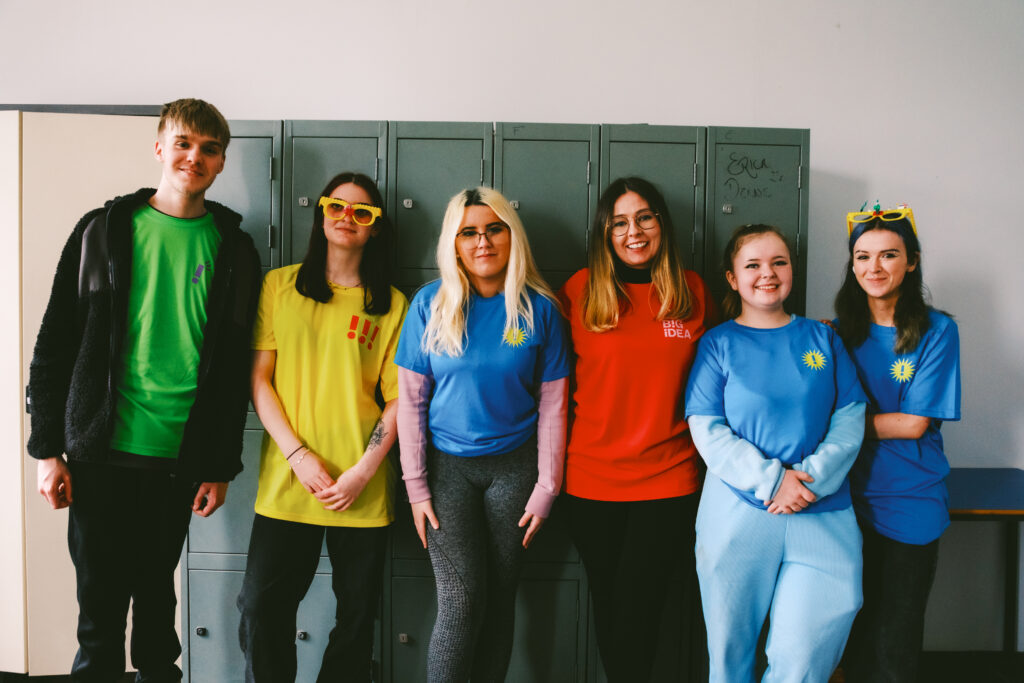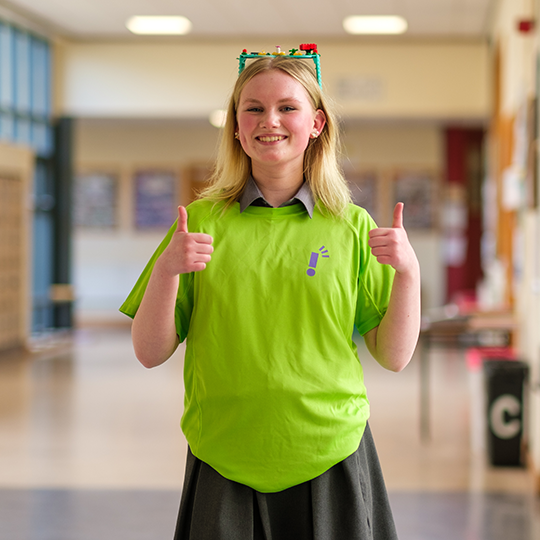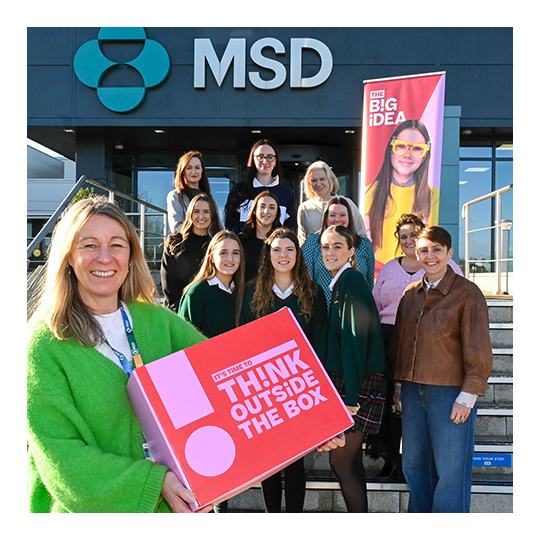The B!G Idea was super excited to be invited to talk at the Responsible Innovation Summit on Thursday 21 October. This is the fifth edition of this annual event, the purpose of which is to explore how to use the power of innovation to create a more sustainable economy. The Instigator and CEO of The B!G Idea, Kim Mackenzie-Doyle spoke with three of our returning Mentors: Stephen Ledwidge, Design Director of RichardsDee; Lorna Ross, Chief Innovation Officer at VHI and Ashwin Chacko, Illustrator and Designer about The B!G Idea and this is what they had to say.
Why do you think creative skills are important facing into the next decade?
Ashwin: It’s important to understand creative problem solving as a method to being adaptable and shift into the new potential positions that are going to turn up in the future. Our education system has not caught up with the innovation of the industry. And so teaching creative skills will really help our students of the next generation to be equipped for the future.
Lorna: There’s a lot of anxiety around the narrative of how much things are broken and there’s not enough conversation about the kind of mindset that we’re going to agree on how we can approach the solutions. It’s just too much talk if it’s very negative., I think it’s really toxic for kids to hear this conversation and not hear a conversation about how we are going to fix things. And so I think that creative problem solving, in general, problem-solving and expansive thinking and collaboration are key to us being optimistic about how we’re going to confront some of these issues.
Stephen: I don’t think skills need to be, or should be, confined to just those who are so-called professionals. It’s like you don’t teach maths only to people who become mathematicians. Creative skills are skills for life, they are skills to be able to work collaboratively in teams, to be able to even have conversations with people.
To give them the tools to, when they do come out into the work or whatever it might be that they have that experience behind them already.
So from your perspective what are the benefits of connecting industry with education?
Ashwin: It’s really important to connect industry with our students because early on you start to learn what things really look like in the real world versus what is taught. Like for myself, when I finished college, there was a vast gap between what I learned and what had to be practiced and put into action. And so having this early interaction actually starts them to think outside of the parameters of education and how they can actually apply the skills that they’re learning in the real world.
Lorna: I was educated in the 70s and I don’t think I knew anyone who was a creative professional. We need an awful lot more designers, we need them to be more present. We need there to be more of them and for them to be more integrated. And so it can’t be the exotics anymore, it can’t be this tiny community of creatives, you know, economically we need a lot more people to be aware of this kind of mindset.
Stephen: It kind of goes two ways. I think the students get something out of it, but the creatives, the Mentors get something out of it as well. I think for the students, that kind of piece of expanded worldview, you know speaking to people who are doing this thing and for them to see the possibility in that. But I think as well for the mentors and I just speak from my own experience, there was such great energy and enthusiasm in terms of engaging with the students and just seeing the quality of the work that came through and, you know, the quality of that kind of thinking and so I certainly felt energised after engaging with that aswell so I think there’s benefits on both sides.
So talking slightly outside of education, what tips would you have for people who are trying to foster a culture of creativity within their own business, whether coming at it from a new perspective or trying to enhance what they’re already doing?
Lorna: I think it’s hard to hire creatives and I mean I’ve hired, I’ve run a lot of design teams and I know that building a design capability is hard. And I think that often, even getting the resources, it’s always competing for something else. So culturally I think creativity has to come in. It has to be top down. I mean, you have to see evidence of it in leadership first. I think it’s really, really hard when creatives get hired in potentially at a junior level, or maybe they’re in the marketing department, or maybe they’re in the UX department and there’s just not a culture. There’s a small group of creatives and the rest of the culture is business as usual, which is maybe thinking in a more linear way. It’s very, very hard for junior designers unless they have a mentor in that organization or someone who’s clearing the way and advocating for design for them to be effective.
So I think it is really important to bring it in at a more senior level and to understand the scope and be really clear about what you want designer to do. Everyone wants innovation and innovation is another word for creativity. It’s just a different way of saying creativity, it’s maybe a more corporate way of saying it because creativity sounds like crayons and kindergarten. So we say innovation, because it sounds a lot more corporate. So I think if it comes in under the guise of innovation. Certainly my career has been in innovation but it’s really about creativity. I think it needs to be a commitment at a senior level first.
Ashwin: I suppose creating a culture of creativity is important. It’s important to distinguish the difference between creatives and creativity itself. I think we’re all born creative, but we forget that fact and it’s important that we teach the people that we work with that they are creative. And then second, creativity is like working a muscle. So you have to create the space to do that. And so creating spaces, inviting people to work with them to build that muscle is an important part of fostering that culture.
Stephen: I think the idea of spaces is so key aswell, physical spaces as well as mental spaces. We run creative workshops with clients frequently and it’s about coming into a space where they feel they can be open in the feedback and discussion and not critically analyse everything the minute they come into a room. It’s allowing ideas the freedom to grow and breathe.
Ashwin: Part of that is actually creating the space and the availability to make mistakes because you cannot have creativity without the ability to explore. And exploration means there will be some failures throughout that process, but those failures help you grow and actually evolve the idea into something even better. And so if you don’t have that space to actually fail, you won’t be able to push the creative envelope.
We all know that education is a big ship and doing many things for many people. And we do teach in silos or subjects with an emphasis on rote learning. Do you think this kills creativity?
Stephen: It can do, I think it goes back to that conversation of open spaces and to understand things in a particular way. I think the way education seems to be moving now where it’s more project based, it’s all about individual learning and student voice and all those kind of pieces. So I think that old model of rote learning is maybe slowly on the way out and it’s moving to the individual and them finding their own way through it. I think there’s different kids and different students all learn in different ways. I myself get to understand things through working through them. I get a mental block if I sit down and try to just learn something but when I get my hands into something and when I start making and taking things apart and putting them together again and that’s so important. That’s one of the things with the kids in The B!G Idea, kids get to get their hands into things and it’s just a different way of thinking and I think that’s so important that there is not just one way of doing things but there’s different ways that different people can approach things and obviously different people can just approach things from different angles.
Lorna: Children understand their brain is a memory and when you are growing up you try to fill it with memories and then retrieve them. There’s this kind of relationship we have with our capacity, our kind of mental kind of cognitive capacity is really limited. And I think that we don’t understand how to teach children the full capacity of what the brain can do in the same way as we have a really funny relationship with our bodies, and we don’t understand how to teach children about others and their bodies. And I think a big part of what’s happening with adolescent mental health is that there’s just not a good enough narrative around understanding identity and understanding emotions and understanding your responses to things and developmentally. And so I think education and how we learn is really, has just been about putting memories in and then retrieving them and not actually having a really intimate relationship with your brain, like not knowing what it’s like, we’re using 10% of it. So I think creativity starts to challenge us to say, what is the other 90% of your brain capable of doing, um, that we aren’t doing? And so I think there’s definitely a kind of a shift and it’s really progressive, but I think the kind of idea that there’s so much more the human brain can do and can perceive and can understand. We can imagine things that are impossible. We can imagine things we’ve never seen. We have the capacity to experiment in our heads, there’s stuff we we just haven’t tapped into and I’d love to see that more in education.
Ashwin: I don’t think we give enough emphasis to good teachers. For example, when I was in school, history is one of the driest, most boring subjects on earth, but fortunately for me, Mr. Johnson came in and he dressed up as a pirate when we’re learning about pirates and he made it interactive. He drew us into the narrative and made it real for us. And so the power of a good teacher will shift the perception of the subject and how it is then taught to the other students or how they are involved in it, shapes how they perceive the subject or the matter in general. And so I think there has to be an emphasis on giving teachers their due credit and change this perception of those who can’t teach because teaching is actually a profound skill. And if done well will shift the career path of a student.
And then just to add on to that, it’s also a question of learning to show students the deeper narrative of why they’re learning, what they’re learning. I find that when they understand the why, a lot more clicks into place, why, why does this work this way? I think if they can see the end goal, then it gives them a pot to move towards versus here’s what you need to learn, just memorize this and that’s the end of that versus if you learn this, this will give you the skills you need to excel at such and such skill or such and such a job.
So onto our next question, you were all mentors on our B!G Idea in our first year and we launched in January. Why have you signed up again as a mentor for 2022?
Lorna: So I guess I would say maybe for all of us, the first time was a bit of a rehearsal. I think that there’s an awful lot that I felt in hindsight I would have done differently. And I think that’s back to the creative processes, it’s really iterative and so you don’t expect to get it right the first time, but I’m going to pay attention. And you see what worked and what didn’t work.
So it feels really important to go back in and to kind of refine the model and to kind of adapt, and evolve. It’s the whole process. It would be crazy to abandon it because we’re just starting to really understand it and its impact. I think that it’s really important to bring back those learnings and to try it again and really refine it and to broaden it as well.
Ashwin: We are responsible for the next generation. We need to foster the change we want to see. And often that means planting the seeds now so that you can see the growth of the tree, 20 or 30 years later. And then like mentoring, it’s also the process of the relationship between the mentee and the mentor. You know, it’s a two way stream and you learn so much from how they’re thinking, you get insight into their landscape versus our own and how that shifts our own perception on the industry, on education and on our world in general. And so it’s really important to have that perspective.
Stephen: I think back to my own time in school and I would have just loved to have something like this in my life but it didn’t exist. There was nothing like this at the time. I just think if there’s kids out there and we can have some kind of impact or help or whatever it might be to them to change their point of view, to open their thinking or perspective up to, do they potentially end up working with these kinds of fields or to just bring this type of thinking into wherever they end up in the world? I just think it’s absolutely amazing. So I’m just delighted to be part of it. I felt really energized for being part of us.
Were there any student projects that stood out to you and why from our first year?
Lorna: There were themes that stood out versus projects. I think the ones that had all the different attributes that we’re looking for in terms of a really great team of collaboration and great experimentation and good exploration and great resolution and solutions and presentations were important. So there were characteristics that we were rewarded for. Looking at the projects, what was lovely was seeing the gender split, there’s a real kind of an equity, males and females working together and that looks really healthy.
And just the representation, that diversity of the teams and how inclusive it was and how much it seemed to bring out everyone’s different and everyone has something to contribute.
I think a big part of the message is that a good team is a really diverse team and it’s diverse in lots of different ways and people who were potentially very quiet in certain environments where they don’t have a voice because they’re not validated, they don’t identify strongly with what’s happening in the classroom. But they were able to bring their skills and they were in a a safe place. So I think rather than that being what stood out, I think just witnessing the team dynamics and the relationship they obviously have with their teachers, I think Ashwin mentioned it, but the teachers were like extraordinary mentors already.
So I think all of the projects and the team dynamic was probably the thing that struck me the most amazing.
Stephen: I suppose it was just looking at the kids and I just thought it was so interesting that they were critically analysing these things and actually just speaking to their peers and using research to be able to find out about things that were affecting them in their lives and just thinking then about solutions. So it was just really, really interesting and a huge breadth of projects that came through. I loved the energy that came through in some of the videos and the different kids within the groups aswell speaking out. So I wouldn’t say one particular project but just what each one was bringing to it and how they were analysing the problems.
Ashwin: So it was really interesting over the last two years, there’s been a huge conversation around diversity and inclusion, and it was great to see the students pick up on these topics and then start asking themselves what can we do to shape and change the culture around this? And it was great to see that they’re not just thinking macro where you get industry to change or pitching ideas like that, but small initiatives within their own school or within an area where they could do little things to shape the conversation around themselves. And the fact that they’re even having the conversation was a great opportunity to see how they’re thinking about it and how they can solve problems for themselves versus waiting for somebody else to do it. So that was really exciting to me to see that process and to actually interact with them and gave them questions where they can pursue further problem-solving within those areas.
Sign up now to join these Mentors for 2022.







